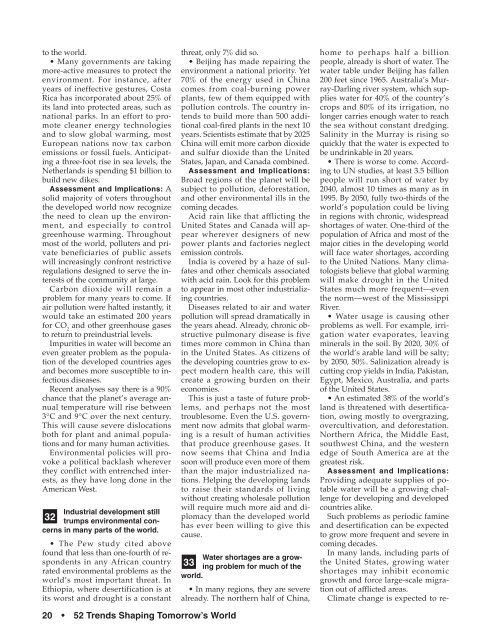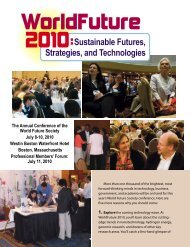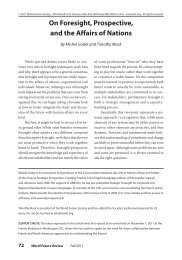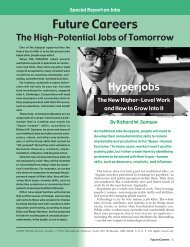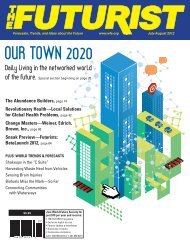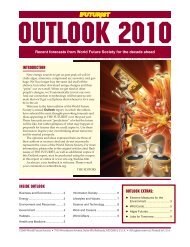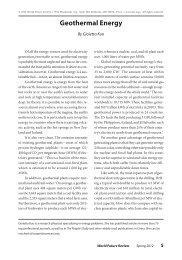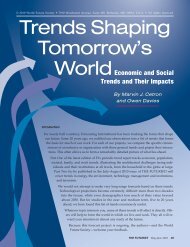52 Trends Shaping Tomorrow's World - World Future Society
52 Trends Shaping Tomorrow's World - World Future Society
52 Trends Shaping Tomorrow's World - World Future Society
Create successful ePaper yourself
Turn your PDF publications into a flip-book with our unique Google optimized e-Paper software.
to the world.• Many governments are takingmore-active measures to protect theenvironment. For instance, afteryears of ineffective gestures, CostaRica has incorporated about 25% ofits land into protected areas, such asnational parks. In an effort to promotecleaner energy technologiesand to slow global warming, mostEuropean nations now tax carbonemissions or fossil fuels. Anticipatinga three-foot rise in sea levels, theNetherlands is spending $1 billion tobuild new dikes.Assessment and Implications: Asolid majority of voters throughoutthe developed world now recognizethe need to clean up the environment,and especially to controlgreenhouse warming. Throughoutmost of the world, polluters and privatebeneficiaries of public assetswill increasingly confront restrictiveregulations designed to serve the interestsof the community at large.Carbon dioxide will remain aproblem for many years to come. Ifair pollution were halted instantly, itwould take an estimated 200 yearsfor CO 2and other greenhouse gasesto return to preindustrial levels.Impurities in water will become aneven greater problem as the populationof the developed countries agesand becomes more susceptible to infectiousdiseases.Recent analyses say there is a 90%chance that the planet’s average annualtemperature will rise between3°C and 9°C over the next century.This will cause severe dislocationsboth for plant and animal populationsand for many human activities.Environmental policies will provokea political backlash whereverthey conflict with entrenched interests,as they have long done in theAmerican West.n 32Industrial development stilltrumps environmental concernsin many parts of the world.• The Pew study cited abovefound that less than one-fourth of respondentsin any African countryrated environmental problems as theworld’s most important threat. InEthiopia, where desertification is atits worst and drought is a constanthome to perhaps half a billionpeople, already is short of water. Thewater table under Beijing has fallen200 feet since 1965. Australia’s Murray-Darlingriver system, which supplieswater for 40% of the country’scrops and 80% of its irrigation, nolonger carries enough water to reachthe sea without constant dredging.Salinity in the Murray is rising soquickly that the water is expected tobe undrinkable in 20 years.• There is worse to come. Accordingto UN studies, at least 3.5 billionpeople will run short of water by2040, almost 10 times as many as in1995. By 2050, fully two-thirds of theworld’s population could be livingin regions with chronic, widespreadshortages of water. One-third of thepopulation of Africa and most of themajor cities in the developing worldwill face water shortages, accordingto the United Nations. Many climatologistsbelieve that global warmingwill make drought in the UnitedStates much more frequent—eventhe norm—west of the MississippiRiver.• Water usage is causing otherproblems as well. For example, irrigationwater evaporates, leavingminerals in the soil. By 2020, 30% ofthe world’s arable land will be salty;by 2050, 50%. Salinization already iscutting crop yields in India, Pakistan,Egypt, Mexico, Australia, and partsof the United States.• An estimated 38% of the world’sland is threatened with desertification,owing mostly to overgrazing,overcultivation, and deforestation.Northern Africa, the Middle East,southwest China, and the westernedge of South America are at thegreatest risk.Assessment and Implications:Providing adequate supplies of potablewater will be a growing challengefor developing and developedcountries alike.Such problems as periodic famineand desertification can be expectedto grow more frequent and severe incoming decades.In many lands, including parts ofthe United States, growing watershortages may inhibit economicgrowth and force large-scale migrationout of afflicted areas.Climate change is expected to rethreat,only 7% did so.• Beijing has made repairing theenvironment a national priority. Yet70% of the energy used in Chinacomes from coal-burning powerplants, few of them equipped withpollution controls. The country intendsto build more than 500 additionalcoal-fired plants in the next 10years. Scientists estimate that by 2025China will emit more carbon dioxideand sulfur dioxide than the UnitedStates, Japan, and Canada combined.Assessment and Implications:Broad regions of the planet will besubject to pollution, deforestation,and other environmental ills in thecoming decades.Acid rain like that afflicting theUnited States and Canada will appearwherever designers of newpower plants and factories neglectemission controls.India is covered by a haze of sulfatesand other chemicals associatedwith acid rain. Look for this problemto appear in most other industrializingcountries.Diseases related to air and waterpollution will spread dramatically inthe years ahead. Already, chronic obstructivepulmonary disease is fivetimes more common in China thanin the United States. As citizens ofthe developing countries grow to expectmodern health care, this willcreate a growing burden on theireconomies.This is just a taste of future problems,and perhaps not the mosttroublesome. Even the U.S. governmentnow admits that global warmingis a result of human activitiesthat produce greenhouse gases. Itnow seems that China and Indiasoon will produce even more of themthan the major industrialized nations.Helping the developing landsto raise their standards of livingwithout creating wholesale pollutionwill require much more aid and diplomacythan the developed worldhas ever been willing to give thiscause.n 33world.Water shortages are a growingproblem for much of the• In many regions, they are severealready. The northern half of China,20 • <strong>52</strong> <strong>Trends</strong> <strong>Shaping</strong> Tomorrow’s <strong>World</strong>


